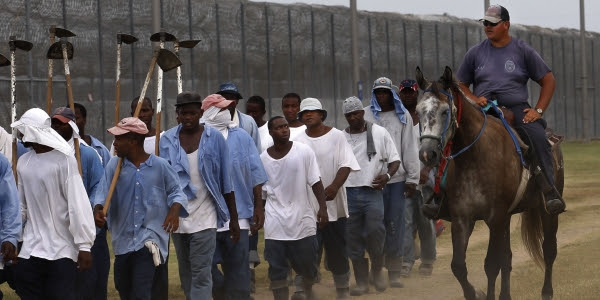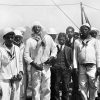 Prisoners and guard at Louisiana State Penitentiary, in Angola, La.
Prisoners and guard at Louisiana State Penitentiary, in Angola, La.
By Jason Stanley
In 1980, there were 500,000 Americans in prison or jail. By 2013, there were more than 2.3 million. The explosion in incarceration has fallen disproportionately on the descendants of slaves. White Americans are 77 percent of the U.S. population, and black Americans 13 percent. Yet more blacks are incarcerated than whites. There has scarcely been a time in history when one group has composed so much of the world’s prison population; black Americans may only be 13 percent of the U.S. population, but they are 9 percent of the world’s prison population.
Black overrepresentation in prison is not fully explained by rates of black offending. There is no credible evidence that blacks use drugs at higher rates than whites, and the evidence that they engage in drug trafficking at higher rates is also at best equivocal. Yet blacks are 10 times as likely to spend time in prison for drug offenses. Blacks have higher rates of property offenses and violent offenses than whites do, which is part of the explanation for the disparity in incarceration. (The drug war may play a role even here, as prior drug offenses may lead to incarceration, rather than probation, for property crimes.)
But I want to focus on a more important question than black-white disparities in offending. Why are harshly punitive measures considered an appropriate response to adverse social conditions among black Americans? What is the source of our lack of empathy for this group?
The civil-rights movement is celebrated as a triumphant realization of freedom, justice, reason, and equality. To view someone as a political equal is an act of respect and empathy. The decades-long growth in black incarceration rates represents a failure of empathy. How could rational people committed to liberal ideals allow such an obvious violation of those ideals to persist? How can such manifest social contradictions be so easily tolerated? Those questions have the characteristic feel of philosophical problems.
The decades-long growth in black incarceration rates represents a failure of empathy.
To understand what’s happened with incarceration in America, you must examine the concepts of propaganda and ideology, especially the kind of propaganda that is most prevalent in liberal democratic societies, which I call undermining propaganda. Undermining propaganda consists of arguments that employ a cherished political ideal in the service of a goal that undermines that very ideal. When it works, we do not even notice the contradiction. Ideology conceals the contradictions of propaganda.
With the philosopher Sally Haslanger, let us take an ideology to be the beliefs, concepts, and practices that constitute one’s social identity. Flawed ideology is what makes certain kinds of problematic propaganda effective. For example, a member of a slave-owning family in the antebellum South might have reconciled his devotion to liberty with the practice of slavery by adopting an ideological belief that blacks were not fully persons. Such a belief would have concealed the true nature of an appeal to liberty to defend the Confederate cause in the Civil War.
The process works in the reverse direction, too. Propaganda can strengthen, and even give rise to, the ideological beliefs that are required to make propaganda pass unnoticed. The history of mass incarceration is a good example.
Science is an important source of authority in a democratic society, and the history of U.S. criminal-justice policy demonstrates the misuse of science. In his 1898 essay, “The Study of the Negro Problems,” W.E.B. Du Bois lamented the “endless final judgments as to the American Negro emanating from men of influence and learning, in the very face of the fact known to every accurate student, that there exists today no sufficient material of proven reliability, upon which any scientist can base definite and final conclusions as to the present conditions and tendencies of the eight million American Negroes; and that any person or publication purporting to give such conclusions simply makes statements which go beyond the reasonably proven evidence.”
There is a wide gap between what social scientists know and the full facts, a gap that is subject to what the Scottish philosopher Alasdair MacIntyre has called “manipulative expertise.” Battles about the putative link between crime and race stretch back more than a century in the sociological literature, to Ida B. Wells and Du Bois. The story is masterfully told in Khalil Gibran Muhammad’s 2010 book, The Condemnation of Blackness (Harvard University Press), in which he shows how white social scientists used race to explain problems among blacks, while appealing to socioeconomic causes to explain the very same problems among whites. Mass incarceration yields many other instances of manipulative expertise.
One particularly important example, both disturbing and revealing, is “super-predator theory,” introduced by, among others, John Dilulio Jr., a political-science professor at Princeton at the time, in a successful attempt to advocate for adult prison sentences for juvenile offenders. The theory postulated a group of “super-predators” with intrinsically violent natures, who “kill, rape, maim, and steal without remorse,” and for whom reform was not an option. In the mid-1990s, Dilulio predicted a large increase in violent crime in the United States from 1995 to 2000. His prediction was treated as credible, despite the fact that violent crime in the United States began dropping in the early 1990s and continued to fall from 1995 to 2000. Dilulio spoke with much more certainty than the evidence warranted. It is reasonable to suspect that this is a case in which ideology explains the large gap between the evidence at hand and how social scientists had interpreted it.
In a 1996 article called “My Black Crime Problem, and Ours,” Dilulio maintained that “not only is the number of young black criminals likely to surge, but also the black crime rate, both black-on-black and black-on-white, is increasing, so that as many as half of these juvenile super-predators could be young black males.” He argues that “the bottom line of most of the best research is that America’s justice system is not racist.” The disparity in incarceration between blacks and whites — which he predicted would grow — was due to the much greater proportion of “super-predators” in the ranks of the former than the latter.
The theory had a large effect on public discourse. In the 1996 election, Bill Clinton and Bob Dole competed over who would be harsher on these “super-predators.” Though its effects are hard to quantify, it seems clear the theory had a large effect on the adoption of draconian and dubiously constitutional policies charging juveniles as adults. The asymmetrical racial application of these laws has been well documented; for example, a 2012 Sentencing Project report shows that 940 out of the 1,579 survey respondents serving life without parole for crimes committed as juveniles were black. Super-predator theory has contributed to a public culture in which black juveniles are viewed as significantly more culpable than white juveniles are.
Dilulio’s belief that there was going to be an explosion of violent crime proved to be wildly wrong. It is reasonable to suspect strong ideological bias at work. Dilulio operated with an uncritical notion of what kinds of policies and procedures are race-neutral. The claim that super-predators with violent natures who kill and maim without remorse are concentrated in the black community is suspiciously close to the belief that blacks are more irredeemably violent than whites. Dilulio’s work is especially problematic if a major causal factor for high levels of inner-city black violence is mass incarceration itself, as Heather Ann Thompson has argued in The Atlantic, along with the criminologist Todd R. Clear, in his 2007 book Imprisoning Communities: How Mass Incarceration Makes Disadvantaged Neighborhoods Worse (Oxford University Press).
Dilulio has repudiated his earlier research and apologized; he is not an explicit racist (and if his views were explicitly racist, so were the views of some among the black American elite who shared them). So what had happened? Dilulio’s position as a scientific expert on the topic of crime and punishment masked even from himself the problematic ideological assumptions of his work. And for the rest of us, his epistemic authority led us to overlook the racist assumptions that prevented him from evaluating the evidence rationally.
Democratic deliberation becomes impossible when figures of authority are allowed to employ incendiary propagandistic rhetoric — not just “super-predator” but also “wilding,” “crack epidemic,” “thug,” and “gang.” These words reduce or eliminate our capacity to think of those to whom they are applied as equals, deserving of empathy. When they are used by authority figures in a democracy, they undermine the very ideals that grant those figures their authority. The misuse of ideals to conceal an agenda that is inconsistent with the correct application of those ideals has been a hallmark of political discourse during the age of mass incarceration.
Consider “sentencing enhancement zones,” more colloquially known as “school drug zones.” These are laws that increase penalties for offenders caught within a certain distance of schools. The arguments in favor of school drug zones employ valued ideals — the protection of children, for example — and appear to be the hallmark of fair, race-neutral legal policies. But school drug zones are not race-neutral. As the Prison Policy Initiative points out, “[s]entencing enhancement laws … create a two-tiered system of justice: a harsher one for dense urban areas with numerous schools and overlapping zones and a milder one for rural and suburban areas, where schools are relatively few and far between.” Such laws place an extra burden on families that live in urban areas, endangering rather than protecting their children.
Even accurate statistics can be used to paint a misleading picture. In a 2010 paper in Law & Society Review, Naomi Murakawa and Katherine Beckett decry “the widespread use of research techniques that disaggregated and decontextualized criminal justice decision making.” For example, treating criminal records as race-neutral ignores how race enters into acquiring a criminal record in the first place, as a result of overpolicing in black neighborhoods. If one is presented only with statistics showing that members of a particular group commit more crimes, one might adopt the view that the group is intrinsically more deviant. Presented with a more complete story, however, one would be less inclined to think of punishment as an appropriate solution to what is primarily a socioeconomic problem.
In a 1981 interview, the Republican strategist Lee Atwater said:
You start out in 1954 by saying, “Nigger, nigger, nigger.” By 1968 you can’t say “nigger” — that hurts you, backfires. So you say stuff like, uh, “forced busing, states’ rights,” and all that stuff, and you’re getting so abstract. Now you’re talking about cutting taxes, and all these things you’re talking about are totally economic things, and a byproduct of them is, blacks get hurt worse than whites. … “We want to cut this” is much more abstract than even the busing thing, uh, and a hell of a lot more abstract than “Nigger, nigger.”
There is a wealth of literature on the success of the Republican-led strategy to connect certain words to associations that are not part of their literal meaning. Look up “welfare” in the dictionary and there is nothing about blacks’ being lazy. “Inner city” does not literally mean a place where black people live. Brittney Cooper has also made a persuasive case that “public” and “private,” too, carry racial associations. Donna Murch is now writing the history of the racial nature of expressions like “war on drugs” and “gang.”
Propaganda allows politicians to signal their allegiance to problematic ideologies, such as racism, that cannot be explicitly endorsed in a liberal democratic society that holds tolerance as an ideal. Electing such politicians rewards and strengthens those who share those flawed ideologies.
Thirteen minutes and forty seconds into Barry Goldwater’s 1964 campaign film Choice, a voice intones, “Your lights may not now be turned off across America. One very simple reason: It’s no longer safe.” As pictures of black Americans stealing from stores during civil unrest flash across the screen, the voice continues, “The new America: Ask not what you can give, but what you can take.” In a 2007 paper in Studies in American Political Development, Vesla Weaver explains how Goldwater led an eventually successful attempt to change the national narrative from one about the violation of ideals of social justice to the violation of ideals of law and order. Weaver argues that perceptions of rising crime, resulting in large part from more accurate reporting, coincided with black protest, suggesting a connection. The result: “depoliticization and criminalization of racial struggle and … racialization of crime.”
How did the United States go from a country that incarcerated roughly 500,000 citizens in 1980 to one that incarcerates roughly 2.3 million today? Civil unrest and rising crime were used to focus public debate on ideals of law and order. Those ideals were then employed to justify a criminal-justice system that, given social conditions, runs counter to race-neutral, fair ideals of law and order. But absent an account of how the misapplication of these ideals was overlooked, the story is only partial.
Sylvia Wynter, a Stanford scholar of African-American studies, began a 1994 article, “‘No Humans Involved’: An Open Letter to My Colleagues,” with the news that “public officials of the judicial system of Los Angeles regularly used the acronym NHI to refer to any case involving a breach of the rights of young Black males who belong to the jobless category of the inner city ghettoes. NHI means ‘no humans involved.’” Wynter’s article links the method of dehumanization of American citizens of African descent to the dehumanization of Armenians by Turkish pan-nationalists in the First World War period, and of Jews by Nazis.
The problem we face as a country is how to “depropagandize” the debate about crime and punishment.
Dehumanizing propaganda — “thug,” “predator”, “gang member” — is employed to hinder any attempt to explore the root causes of disorder. When blacks protest in response to social injustice, it creates disorder. When crime rates rise, it creates disorder. Propaganda mixed with fear leads to tolerance of injustice. The use of propaganda allows us to overlook gross inequities in the treatment of those to whom the propagandistic vocabulary is applied, inequities that are inconsistent with political equality.
The problem we face as a country is how to “depropagandize” the debate about crime and punishment, so we can think in a sophisticated way about how to address social disruption. Here we must look to history to gauge the difficulty of the task. The language used under Nazism contained many constructs that served as keystones of ideologies, primes that evoke the whole ideology. Some were obvious, others less so. It was a matter of difficulty to locate and neutralize them. A passage from Victor Klemperer’s 1947 book, The Language of the Third Reich, from a chapter about the postwar period in Germany, speaks to the difficulty of the task:
I have observed again and again how the young people in all innocence, and despite a sincere effort to fill the gaps and eliminate the errors in their neglected education, cling to Nazi thought processes. They don’t realize they are doing it; the remnants of linguistic usage from the preceding epoch confuse and seduce them. We spoke about the meaning of culture, or humanitarianism, of democracy and I had the impression that they were beginning to see the light, and that certain things were being straightened out in their willing minds — and then, it was always just round the corner, someone spoke of some heroic behavior or other, or of some heroic resistance, or simply heroism per se. As soon as this concept was even touched upon, everything became blurred, and we were adrift once again in the fog of Nazism.
In the past 35 years, the population of U.S. citizens who are incarcerated has increased more than fourfold. The lack of empathy toward those caught in the grip of the prison system is not consistent with the ideals of liberal democracy. There is, for example, no national outcry about the tens of thousands of Americans subject to long-term solitary confinement, despite vivid accounts of its horrors. Prison rape continues to be a topic for comedy routines.
History has taught that the process of ridding our speech and thought of dehumanizing associations is not simple. But it is clear enough how to begin: with a zero-tolerance policy for politicians, journalists, and scientists who employ dehumanizing propaganda in public discourse about crime. At the very least, we should agree that it is not possible to make democratic decisions about the structural problems in our society when thinking of our fellow citizens as gangsters and thugs.
Jason Stanley is a professor of philosophy at Yale University. He is the author of How Propaganda Works, just out from Princeton University Press.















